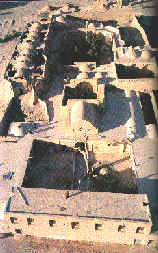|
|
History of Yazd Province to Timurid era:
As far as mythology is concerned, the primary construction of parts of Yazd, such as Meibod, has been ascribed to prophet Solomon, while Yazd city and Abarkouh are believed to have been founded by Zahhak (a mythological king) and prophet Abraham, respectively. Stone hand-tools discovered in Shirkouh valleys, drawings engraved on a boulder in Mount Ernan, and pieces of engraved tiles discovered in Meibod's Narain Castle, which researchers believe belong to Elamite era are all indicative of Yazd's very rich heritage handed down from an ancient and well-rooted culture and civilization.
Yazd's own civilization began flourishing at the outset of the agriculture era in four main areas including Mehriz and Fahraj,Yazd, Rostagh and Meibod and maybe Abarkouh region. These regions, which were along the ancient Rey-Kerman Highway, were considered as part of the remote territories of the Mede Empire in the ancient times.
In Achaemenid Monarch, the region enjoyed well-established routs, roads, maintenance posts, postal service and horse-changing centers. Yazd was mainly as a trade transit route. There are evidences of the worship of sun and the sun goddess, Anahita, by the region's inhabitants long before the dissemination of neo-Zoroastrian religion.
The region was conquered by Arab in the 8th century AD and as of the second half of the same century, some Arab from Bani-Tamim and Bani-Amer entered Yazd and resided in a place later known as “Arabs' Neighborhood”.
Later, in 1033 AD, Seljuk Toghrol exchanged Yazd and Abarkouh for Isfahan, with Zahiruddin Abou Mansour Faramarz Kakoui. Kakoui Dynasty rulers embarked on many useful projects and made considerable efforts in developing the city and attending to public welfare. They built numerous schools and subterranean canals to irrigate the city's quarters and small towns around it.
During Alaoddoleh Kakoui's region, a rampart was erected around the city for the first time. Also, four ironclad gates were placed at four entrances to the city. The last of Kakoui Dynasty's rulers, Amir Faramarz, established a village around Abrandabad, which was later known as the Faramarz Gerd.
It was during Sultan Ghotbeddin's rule, when Mongol conqueror Genghiz Khan invaded Iran. Ghotbeddin accepted the Mongol domination and his successors were reinstated in Yazd as Mongol appointees and they thus saved the city from destruction with their competence and political acumen. Since Iran's southern provinces had fallen to Mongol Conquerors by then, Yazdi commodities could reach beyond Iran's southern waters, especially, India. Yet, the only problem was the safety of routes leading to target markets.
The situation of Yazd on the desert's margin was frightening to caravans as they would be subject to bandits' attacks from every direction while passing that route. Mongol rulers then appointed Sharafoddin Mozaffar, father of Amir Mobarezeddin Mohammad, to put down the bandits' threat. He took the challenge with all of his might and suppressed the bandits to the point that according to a book entitled Majmaal-Ansab. He would deliberately leave bags if gold and silver on passageways and no one dared touch them! Within the century that Mongol ruled Iran, Yazd expanded two-fold and was turned into a political center under Mozaffar dynasty, especially during the time of its founder, Amir Mobarezeddin Mohammad. It has been reported that Mozaffar’s Family rulers were Arab, who had migrated to Iran in the early days of Islam, and had resided in Khorasan’s Khaph region.
Though Mozaffar Dynasty's rule was suppressive towards people in other regions, it was rather tolerant to the people of Yazd. As such, Yazd's culmination of material and cultural development occurred during the same era. The number of schools built in Yazd at the time was totally unrivalled compared to that of any other area across Iran. This cultural development expanded to the point, which won the title “House of Knowledge” for the city. Various branches of knowledge and sciences were taught in Yazd's schools. It should be noted that mysticism saw a very prosperous era across the province during the region of Mozaffar's Family.

Fahraj
|
|

